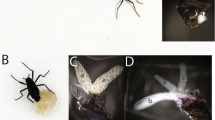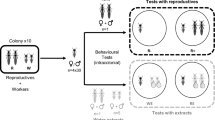Abstract
Trans-generational transfer of gregarious-phase traits in the desert locust Schistocerca gregaria (Forskål, 1775) is mediated by primer gregarizing pheromonal signals produced by ovipositing females that experience crowding. We monitored time-course proteomic events in eggs from solitary-reared locusts that had been exposed for 1, 3, 5, 7, 10 and 12 days to different levels of the sand-associated gregarizing signal originating from 0, 3, 5 or 10 ovipositions by crowd-reared females. Evidence for the phase transition was sought by comparing the protein patterns of embryos thus exposed with those from crowd-reared (gregarious) controls; this comparison was continued until the stage of the first instars. Expressed proteins were analysed by two-dimensional protein gel electrophoresis, and patterns from the different treatments within stages were compared by profile matching and χ2 analyses. Eggs derived from crowd- and solitary-reared females showed essentially similar protein patterns at early stages of embryogenesis; however, mature stages (particularly, days 10 and 12) and hatchlings demonstrated significantly different patterns. Protein patterns of eggs from solitary-reared females that were incubated in sand contaminated with the pheromonal signal and of the hatchlings that emerged were similar to those derived from gregarious females and dependent on the level of the pheromone to which the embryos had been exposed. The results confirm the gregarizing effect of the signal and constitute a useful basis for unravelling the mechanism of the signalling cascades associated with gene expressions triggered by the pheromone.
Similar content being viewed by others
References
Applebaum S. W., Avisar E. and Heifitz Y. (1997) Juvenile hormone and locust phase. Archives of Insect Biochemistry and Physiology 35, 375–391. doi:10.1002/(SICI)1520-6327(1997)35:4< 375: AID-ARCH3> 3.0. CO;2-R.
Bashir M. O., Hassanali A., Rai M. M. and Saini R. K. (2000) Changing oviposition preferences of the desert locust, Schistocerca gregaria, suggest a strong species predisposition for gregarization. Journal of Chemical Ecology 26, 1721–1733.
Bouaïchi A., Roessingh P. and Simpson S. J. (1995) An analysis of the behavioural effects of crowding and re-isolation on solitary-reared adult desert locusts (Schistocerca gregaria) and their offspring. Physiological Entomology 20, 199–208. doi:10.1111/j.l365-3032.1995.tb00002.x.
Bouaïchi A., Simpson S. J. and Roessingh P. (1996) The influence of environmental microstructure on the behavioural phase state and distribution of the desert locust Schistocerca gregaria. Physiological Entomology 21, 247–256.
Chongsuvivatwong V. (2012) Epicalc: epidemiological calculator. R package version 2.14.1.6. Available at: http://CRAN.R-project.org/package=epicalc.
Deng A. L., Torto B., Hassanali A. and Ali E. E. (1996) Effects of shifting to crowded or solitary conditions on pheromone release and morphometrics of the desert locust, Schistocerca gregaria (Forskål) (Orthoptera: Acrididae). Journal of Insect Physiology 42, 771–776. doi:10.1016/0022-1910(96)00015-7.
Hagele B. E, Oag V., Bouaïchi A., McCaffery A. R. and Simpson S. J. (2000) The role of female accessory glands in maternal inheritance of phase in the desert locust, Schistocerca gregaria. Journal of Insect Physiology 46, 275–280.
Hassanali A., Bashir M. O., Njagi P. G. N. and Ely S. O. (2005a) Desert locust gregarization: a conceptual kinetic model. Journal of Orthoptera Research 14, 223–226.
Hassanali A., Njagi P. G. N. and Bashir M. O. (2005b) Chemical ecology of locusts and related acridids. Annual Review of Entomology 50, 223–245.
Islam M. S., Roessingh P., Simpson S. J. and McCaffery A. R. (1994a) Parental effects on the behaviour and colouration of nymphs of the desert locust Schistocerca gregaria. Journal of Insect Physiology 40, 173–181.
Islam M. S., Roessingh P., Simpson S. J. and McCaffery A. R. (1994b) Effects of population density experienced by parents during mating and oviposition on the phase of hatchling desert locusts, Schistocerca gregaria. Proceedings of the Royal Society B 257, 93–98.
Jones J. S. (1980) How much genetic variation? Nature 288, 10–11.
Kiely M. L. and Riddiford L. M. (1985a) Temporal programming of epidermal cell protein synthesis during the larval-pupal transformation of Manduca sexta. Wilhelm Roux’s Archives of Developmental Biology 194, 325–335.
Kiely M. L. and Riddiford L. M. (1985) Temporal patterns of protein synthesis in Manduca epidermis during the change to pupal commitment in vitro: their modulation by 20-hydroxyecdysone and juvenile hormone. Wilhelm Roux’s Archives of Developmental Biology 194, 336–343.
Laemmli U. K. (1970) Cleavage of structural proteins during the assembly of the head of bacteriophage T4. Nature 227, 680–685. doi:10.1038/227680a0.
Malual A. G., Hassanali A., Torto B., Assad Y. O. H. and Njagi P. G. N. (2001) The nature of the gregarizing signal responsible for maternal transfer of phase to the offspring in the desert locust, Schistocerca gregaria. Journal of Chemical Ecology 27, 1423–1435.
Miller G. A., Islam M. S., Claridge T D. W., Dodgson T. and Simpson S. J. (2008) Swarm formation in the desert locust Schistocerca gregaria: isolation and NMR analysis of the primary maternal gregarizing agent. Journal of Experimental Biology 211, 370–376.
Njagi P. G. N., Torto B., Obeng-Ofori D. and Hassanali A. (1996) Phase-independent responses to phase-specific aggregation pheromone in adult desert locusts, Schistocerca gregaria (Orthoptera: Acrididae). Physiological Entomology 21, 131–137. doi:10.1111/j.l365-3032.1996.tb00845.x.
Norris M. J. (1968) Laboratory experiments on oviposition responses of the desert locust, Schistocerca gregaria (Forskål). Anti-Locust Bulletin 43, 1–47.
Ochieng-Odero J. P. R., Ndugo S. M., El Bashir S. and Capstick P. B. (1994) A method for rearing crowded (gregarious) and isolated (solitary) locusts (Orthoptera: Acrididae) in the laboratory, pp. 33–44. In Proceedings of a Workshop on Effective Networking of Research and Development on Environmentally Sustainable Locust Control Methods among Locust Affected Countries (edited by P. G. N. Njagi and M. F. B. Chaudhury). ICIPE Science Press, Nairobi.
O’Farrell P. H. (1975) High resolution two-dimensional electrophoresis of proteins. Journal of Biological Chemistry 250, 4007–4021.
O’Farrell P. Z., Goodman H. M. and O’Farrell P. H. (1977) High-resolution two-dimensional electrophoresis of basic as well as acidic proteins. Cell 12, 1133–1142.
Pener M. P. (1983) Endocrine aspects of phase polymorphism in locusts. In Downer R. G. H. and Laufer H. (eds), Endocrinology of Insects, pp. 379–394. New York: Alan R. Liss, Inc.
Pener M. P. (1991) Locust phase polymorphism and its endocrine relations. Advances in Insect Physiology 23, 1–79.
Pener M. P. and Yerushalmi Y. (1998) The physiology of locust phase polymorphism: an update. Journal of Insect Physiology 44, 365–377.
R Development Core Team (2011) R: A Language and Environment for Statistical Computing. R Foundation for Statistical Computing, Vienna, Austria. ISBN 3-900051-07-0. Available at: http://www.R-project.org.
Roessingh P. and Simpson S. J. (1994) The time-course of behavioural phase change in nymphs of the desert locust, Schistocerca gregaria. Physiological Entomology 19, 191–197. doi:10.1111/j.l365-3032.1994.tb01042.x.
Saini R. K., Rai M. M., Hassanali A., Wawiye J. and Odongo H. (1995) Semiochemicals from froth of egg pods attract ovipositing female Schistocerca gregaria. Journal of Insect Physiology 41, 711–716.
Simpson S. J. and Miller G. A. (2007) Maternal effects on phase characteristics in the desert locust, Schistocerca gregaria: a review of current understanding. Journal of Insect Physiology 53, 869–876.
Uvarov B. P. (1966) Grasshoppers and Locusts: A Handbook of General Acridology: Volume 1. Anatomy, Physiology, Development, Phase Polymorphism, Introduction to Taxonomy. Cambridge University Press, London. 481 pp.
Wedekind-Hirschberger S., Sickold S. and Dorn A. (1999) Expression of phase-specific haemolymph polypeptides in a laboratory strain and field catches of Schistocerca gregaria. Journal of Insect Physiology 45, 1097–1103.
Author information
Authors and Affiliations
Corresponding author
Rights and permissions
About this article
Cite this article
Khamis, F.M., Mireji, P.O., Osir, E.O. et al. Biochemical changes in developing embryos of Schistocerca gregaria (Orthoptera: Acrididae) induced by pheromone produced by ovipositing gregarious females. Int J Trop Insect Sci 35, 125–131 (2015). https://doi.org/10.1017/S1742758415000119
Accepted:
Published:
Issue Date:
DOI: https://doi.org/10.1017/S1742758415000119




